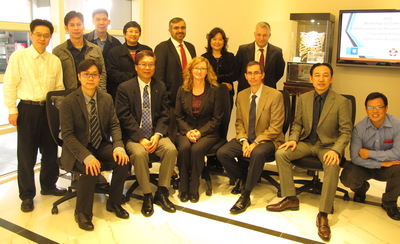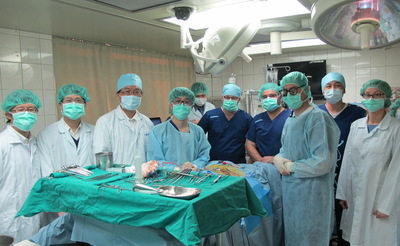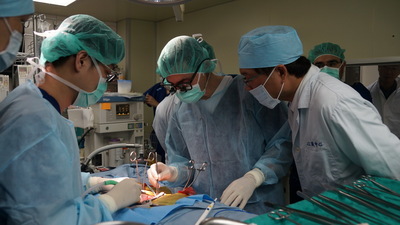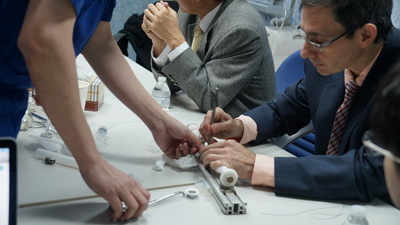NCKU, Duke collaborate to better design a ventricular assist device




Tainan, Taiwan, December 23, 2015
A workshop involving doctors and researchers from National Cheng Kung University (NCKU) and Duke University School of Medicine was held on the morning of December 22 at the Heart Science and Medical Devices Research Center, NCKU. After workshop, they carried out an in-vivo test of the para-aortic blood pump (PABP) ventricular assist device implantation on calf.
Dr. Carmelo A. Milano, the Professor and Surgical Director for Heart Transplant and LVAD Program, Dr. Mani Daneshmand, Dr. Roberto Manson and Dr. Dawn E. Bowles from Duke University School of Medicine were invited by Prof. Pong-Jeu Lu, the inventor of PABP, to attend the workshop and surgery.
Professor Lu has been leading his research team to develop the PABP for over fifteen years. He said, PABP is a new type of left ventricular assist device which has completed major design, prototype manufacturing and testing after more than 10 years of effort.
He also noted that the PABP is designed to provide long-term counter-pulsation therapeutic support, minimize bleeding complication, and support the ultimate goal of bridge-to-recovery.
The current stage of design is focusing on simple and safe implantation for minimally invasive surgery, minimizing device and surgical costs to increase affordability, according to Prof. Lu.
“It has been significant improvement in the design and the deployment of the device,” said Dr. Daneshmand adding, “It’s getting closer to the intended goal which is a minimum invasive implant.”
He also said, we’re very proud of how much effort Professor Lu and his team put into this excellent development.
Professor Lu mentioned the improvement in design of the blood pump from one-piece to two pieces.
Dr. Milano explained, “Having the device into two pieces made the introduction of the aorta easier, reducing the difficulty with the insertion for the device.”
After examining the device, Dr. Milano said, “The material is very good and the connection system seems to be very good between the two pieces. So we think it’s a step forward,” Dr. Milano added.
In the workshop, they developed ways to make the device easier to be inserted into the aorta.
According to Dr. Milano, if the device goes into the aorta with fraction or with difficulty is potential damage to the aorta. Inserting the device easily in a reproducible manner is important and hopefully prevents any injury to the aorta during the insertion.
“I think the device will be incredibly useful in American market,” said Dr. Manson adding, “It is simple and it has a function that none of the current devices have because it bridges to recovery.”
“And it’s reliable and inexpensive which would be not only good therapeutically but also doing a good to a lot of needy people,” he added.
“Thanks to a lot of support from NCKU,” said Dr. Manson. “It’s exciting to see this project from a dream coming to an idea turning into a small device,” he said.
The team successfully implanted the device on a calf on the afternoon of December 22.
Professor Lu noted, “Our goal is for first in human use in 2018.”
Enditem/
A workshop involving doctors and researchers from National Cheng Kung University (NCKU) and Duke University School of Medicine was held on the morning of December 22 at the Heart Science and Medical Devices Research Center, NCKU. After workshop, they carried out an in-vivo test of the para-aortic blood pump (PABP) ventricular assist device implantation on calf.
Dr. Carmelo A. Milano, the Professor and Surgical Director for Heart Transplant and LVAD Program, Dr. Mani Daneshmand, Dr. Roberto Manson and Dr. Dawn E. Bowles from Duke University School of Medicine were invited by Prof. Pong-Jeu Lu, the inventor of PABP, to attend the workshop and surgery.
Professor Lu has been leading his research team to develop the PABP for over fifteen years. He said, PABP is a new type of left ventricular assist device which has completed major design, prototype manufacturing and testing after more than 10 years of effort.
He also noted that the PABP is designed to provide long-term counter-pulsation therapeutic support, minimize bleeding complication, and support the ultimate goal of bridge-to-recovery.
The current stage of design is focusing on simple and safe implantation for minimally invasive surgery, minimizing device and surgical costs to increase affordability, according to Prof. Lu.
“It has been significant improvement in the design and the deployment of the device,” said Dr. Daneshmand adding, “It’s getting closer to the intended goal which is a minimum invasive implant.”
He also said, we’re very proud of how much effort Professor Lu and his team put into this excellent development.
Professor Lu mentioned the improvement in design of the blood pump from one-piece to two pieces.
Dr. Milano explained, “Having the device into two pieces made the introduction of the aorta easier, reducing the difficulty with the insertion for the device.”
After examining the device, Dr. Milano said, “The material is very good and the connection system seems to be very good between the two pieces. So we think it’s a step forward,” Dr. Milano added.
In the workshop, they developed ways to make the device easier to be inserted into the aorta.
According to Dr. Milano, if the device goes into the aorta with fraction or with difficulty is potential damage to the aorta. Inserting the device easily in a reproducible manner is important and hopefully prevents any injury to the aorta during the insertion.
“I think the device will be incredibly useful in American market,” said Dr. Manson adding, “It is simple and it has a function that none of the current devices have because it bridges to recovery.”
“And it’s reliable and inexpensive which would be not only good therapeutically but also doing a good to a lot of needy people,” he added.
“Thanks to a lot of support from NCKU,” said Dr. Manson. “It’s exciting to see this project from a dream coming to an idea turning into a small device,” he said.
The team successfully implanted the device on a calf on the afternoon of December 22.
Professor Lu noted, “Our goal is for first in human use in 2018.”
Enditem/
Provider:
NCKU News
Date:
2015/12/23